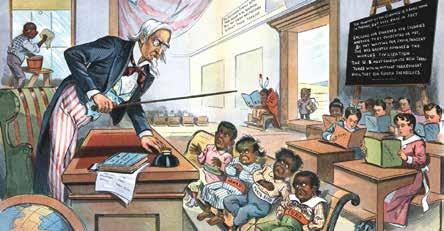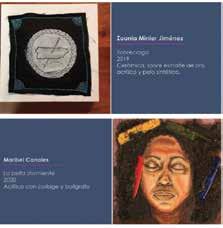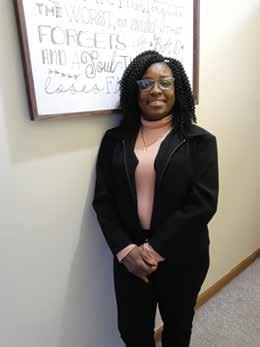
34 minute read
Dems Introduce Bill to Let Puerto Ricans ‘Determine Their Own Political Future
Originally published on COMMONDREAMS.ORG | March 18, 2021 Amid renewed debates over Puerto Rican statehood given Democratic control of both Congress and the White House, a trio of lawmakers on Thursday reintroduced a bill that would allow residents of the U.S. island territory to chart their own political path. Reps. Nydia Velázquez (D-N.Y.) and Alexandria Ocasio-Cortez (D-N.Y.) joined with Sen. Bob Menendez (D-N.J.) to introduce the Puerto Rico Self-Determination Act of 2021, which aims to “empower Puerto Ricans with an inclusive and democratic process to determine their own political future and relationship with the United States” through a status convention with elected delegates. “Over a century ago, the United States invaded Puerto Rico. And ever since the U.S. has pursued its own colonial rule,” said Velázquez, who was born in the territory. “While many may disagree about the future of Puerto Rico’s status, we must recognize that the decision should come from those who will be impacted most: the people of Puerto Rico.” “That is why we are introducing the Puerto Rico Self-Determination Act,” she continued. “After over 100 years of colonial rule, Puerto Ricans would finally have a democratic mechanism to determine their own future.”
After over one hundred years of colonial rule, Puerto Ricans would have a mechanism to determine their own future.
Advertisement
This bill introduced just now would provide a democratic option by giving the Puerto Rican people a chance to make their voices heard in two open elections. pic.twitter.com/kJI7WjISZo — Rep. Nydia Velazquez (@NydiaVelazquez) March 18, 2021 The reintroduction comes about two weeks after Rep. Darren Soto (D-Fla.), who is of Puerto Rican descent, and Jenniffer González Colón—a Republican who serves as the resident commissioner of Puerto Rico in Congress—introduced the Puerto Rico Statehood Admission Act. Ocasio-Cortez, who is also of Puerto Rican descent, echoed her recent remarks about the statehood bill versus the legislation she is co-leading. “The principled position—especially for the head of that colonizing power— is to say that people should have a process of self-determination and to not put your thumb on the scale of one direction or another,” she said Thursday. “Our bill outlines a just, democratic, and inclusive process for Puerto Ricans to decide their future.” Menendez similarly argued that “the more than three million residents of Puerto Rico deserve a comprehensive and fair process to chart their own path forward.” “This is the most inclusive approach to addressing the long-overdue question of Puerto Rico’s political status,” he said, “but most importantly, it offers the people of Puerto Rico a legitimate and democratic process to determine their own future.” Velázquez and Ocasio-Cortez first unveiled the legislation last summer. At the time, they co-wrote an opinion piece for NBC News, detailing how “Puerto Rico has been subjected to policies foisted on it by a Congress frequently uninterested in the welfare of those who live there.” As the congresswomen explained:
This reality touches every aspect of Puerto Rican life: Puerto Rico receives disparate treatment for Medicaid reimbursement, nutritional support, and a host of other safety net programs, despite being poorer than the poorest state. These problems and others stem from Puerto
Rico’s unique, long-standing colonial status, which has resulted in the island’s residents being treated as second-class citizens.
continued on page 12
… an Exercise in Dishonest Paternalistic Colonialism continued from page 7
This is a bad bill because at the heart of it lies the premise that the residents of Puerto Rico can’t choose their politcal future and status directly in a congress-sponsored binding referendum. This is the same type of paternalist colonial mentality that turned Puerto Rico into an American colony in 1898. This bill should be boycotted because it is an exercise in colonialism that perpetuates the already colonial status quo. Because only one choice will be presented to the Puerto Rican electorate- those who don’t like the option chosen by the delegates and the bilateral commission (whose members are not elected), can simply boycott the referendum and claim the voter turnout doesn’t support a status change. Congress then, will agree or disagree with that claim depending on the status presented in the referendum. Congress also retain the right to do NOTHING after the referendum. Nothing at all! So, in sum, not only does this bill make the Puerto Rican electorate a supporting character in their own story, but it also includes too many mechanisms for Congress to manipulate the choice presented to the Puerto Rican electorate, AND to ignore their will even if after including all these mechanisms and undue influence- the Puerto Ricans choose an option that the Democratic leaders in Congress don’t support. This is a betrayal of democratic principles and values. Call on @NydiaVelazquez @AOC @BernieSanders @SenSchumerto to withdraw this piece of paternalistic colonial legislation. The residents of Puerto Rico are capable enough to decide their politcal future in a direct referendum. Let’s make sure that the will and the voices of the people of Puerto Rico are not drowned by yet another act of dishonest paternalistic colonialism.
HARRY FRANQUI-RIVERA is a historian by training, a professor of history by day, and a public intellectual and blogger by night. I’m the author of: Soldiers of the Nation: Military Service and Modern Puerto Rico, 1868-1952. University of Nebraska Press, 2018. You can find his academic work at: http://www.academia.edu/ and he also write and blog about current issues, from politics to foreign policy, military matters, identity, culture, race and privilege. You can find my most popular works in; Latino Rebels www.latinorebels.com/author/harryfranquirivera, Centro Voices - centropr.hunter.cuny.edu/centrovoices, www.huffingtonpost.com/author/harryfranquirivera-315 and 80Grados- www.80grados.net/author/harry-franqui-rivera/. Follow him @hfranqui.
Publisher: Durham, NC: University of North Carolina Press, 2020. 480p. • Reviewer: ANDRÉS TORRES | February 2021 This review was originally published on Criminal Law & Criminal Justice Books – (clcjbooks.rutgers.edu) East Harlem and the South Bronx, two of the most distressed neighborhoods of New York City, produced an extraordinary outburst of grassroots political radicalism over the course of three pivotal years in American history. The emergence of the militant Young Lords, young Puerto Rican (and some African American) activists of poor and working-class backgrounds, shocked the political establishment and altered perceptions of civil rights and Black Power protests. The Young Lords (the label encompasses the two phases of the groups’ early history: Young Lords Organization and Young Lords Party) effected at least a dozen consecutive actions between 1969 and 1971, directing the community’s anger and frustration with systemic oppression directly at the “establishment.” A demand for respect and a passionate caring for their people moved the Young Lords to act on Ernesto “Che” Guevara’s precepts: “The true revolutionary is guided by great feelings of love” and “Let’s be realistic. Let’s do the impossible!” Johanna Fernández’s The Young Lords: A Radical History is the definitive work on this political organization and tells the fascinating story with rich detail and narrative drama. In eleven chapters the author documents the groups’ early gang beginnings, its transformation into a media-savvy, community-based socialist organization that employed dramatic, attentiongrabbing actions, and how it came to its ultimate demise. These activists confronted race and class inequality and linked local problems to international crises and American foreign policy. They employed a variety of bold and sometimes outlandish actions that ranged from urban guerilla-style interventions of a few days to lengthy, highly planned occupations. Fernández places in historical context New York City’s health care, social welfare, education, and criminal justice systems to demonstrate how city institutions had kept poor people in vulnerable and depressed conditions. Her research is based on interviews with former members (more than are available in any previous work), multiple media and documentary accounts, and archival records, including those of COINTELPRO that were released after a long Freedom of Information Law request and a court battle. Several chapters in this 480-page volume bear the title of key actions taken by the Young Lords, i.e., “The Garbage Offensive”, “The Lead Offensive”, “The Church Offensive”, and “The Lincoln Hospital Offensive”. This allows Fernandez to delve deeply into the specifics of each event in chronological order, documenting efforts to elevate community control and enact reform, the group’s direct confrontations with police, and muckraking journalism efforts. The author also describes engagement with other advocacy groups and the enactment of sophisticated coalition politics. Fernandez’s history integrates substantial material on the original Young Lord’s Chicago chapter, explaining how it briefly joined with its New York City counterpart. Although the author suggests activity in cities throughout the Puerto Rican Diaspora, she gives few details of community organizing beyond the New York CityChicago nexus. Fernandez’s discussion of the group’s theoretical positions on internal colonialism, self-determination, and revolutionary nationalism are informative, as are questions of racial and gender identity. The Young Lord perspective challenged all Americans “to step outside their United Statescentered and narrow grasp of race and identity” (p. 269) and female members challenged patriarchy internally, for example, overturning statement favoring “revolutionary machismo,” and externally, with nuanced critiques of white feminist positions on abortion and reproductive rights (see Morales, 2016). The Young Lords were distinct from previous political efforts in four important ways: the organization 1) was the first radical political collectivity to engage and mobilize second-generation Puerto Ricans; 2) proudly embraced the African component in Boricua history, culture and identity; 3) elevated, despite internal resistance, the role of women within radical activism; 4) and held that the most marginalized should be at the forefront of a movement’s concerns and leadership. Entering the 1970s, the Young Lords were the entity that acted on these ideas in a systematic way. Fernández’s political analysis tends to favor the “radical” side of Young Lord politics, but she is careful to note the community service programs embodied in the call to “Serve the People”, and that grassroots organizing is the necessary prelude to changing political consciousness. The book is a laudatory treatment but does not refrain from pointing out the Young Lords’ flaws and missteps. Toward the end of 1970, the militants’ armed occupation of a church seemed a step to far. The action ended without fatalities, but disenchantment arose among both community residents and members. The blistering pace of activism began to subside. The Young Lords gradually fell victim to intense political in-fighting, much of it revolving around the dominance of centralized leadership, a push for rapid expansion, and questions as to organizational purpose. By 1974, interrogation and physical torture of members accused of being “enemies of the people”, rendered the organization dysfunctional (pp. 371-373). Fernández concludes with descriptions of FBI penetration of the leadership. The spirit of love and compassion for the people that inspired the beginnings had given way to self-destruction and a painful demise. As a participant in the political struggles of these times this reviewer would have appreciated more discussion of the larger Puerto Rican movement and the afterlife of the Young Lords, particularly coverage of the Puerto Rican Socialist Party and El Comité-MINP (Puerto Rican National Left Movement). These and other organizations continued to actively organize well into the 1980s, with important coalitional efforts involving former Young Lord activists (see Velázquez, Rivera and Torres, 2021). The current volume would be enhanced by telling the story of major campaigns such as the Save Hostos movement, the fightback against the mid-1970s austerity regime during the NYC fiscal Crisis, the National Day of Solidarity with Puerto Rico, and the Bicentennial without Colonies mobilizations. Additional coverage might include the final liberation of the Nationalist Prisoners, the Vieques Solidarity work, and forays into electoral politics. These struggles mobilized tens of thousands of Puerto Ricans, Latinos, and other supporters, and exhibit the vibrancy that characterized the Puerto Rican movement well into the 1980s. Without these references, readers might falsely assume that the Puerto Rican Left disappeared with the end of Young Lord activism. I highly recommend this book for readers interested in U.S. social movement history. Fernández presents a lively narrative of an iconic organization. The story brims with exciting episodes, life stories of the main protagonists, vital lessons from grassroots organizing, and cautionary notes for today’s activists. It reminds us that authentic movements for change begin with a deep love for and commitment to the oppressed. Losing this focus will lead revolutionaries astray; what is achieved in times of passionate and selfless commitment can leave a lasting legacy.
References
Morales, Iris. Through the Eyes of Rebel Women: The Young Lords, 19691976. New York: Red Sugarcane Press, Inc. 2016. Velázquez, José E., Carmen Vivian Rivera, and Andrés Torres, eds. Revolution Around the Corner: Voices from the Puerto Rican Socialist Party in the United States. Philadelphia: Temple University Press, 2021. Andrés Torres is retired Distinguished Lecturer, Lehman College, City University of New York.
El rizo y la trenza: nueva exposición virtual en la Galería de Arte del RUM
MAYAGÜEZ, PR | UNIVERSIDAD DE PUERTO RICO – MAYAGÜEZ | 8 de marzo de 2020 – La Galería de Arte del Departamento de Humanidades del Recinto Universitario de Mayagüez (RUM) de la Universidad de Puerto Rico (UPR) inauguró esta semana la exposición virtual El rizo y la trenza, que reúne a cuatro artistas puertorriqueñas, quienes cuestionan, a través de su arte, el racismo construido en Puerto Rico y en el Caribe. La muestra digital contiene una treintena de piezas de las artistas Maribel Canales, Nitzayra Leonor, Zuania Minier Jiménez y Yolanda Velázquez producidas en diversos medios, incluyendo fotografía, tejido, cerámica, pintura y xilografía, entre otros. Sus propuestas están relacionadas con el cabello, con el fin de visibilizar la naturalidad de la imagen afrocaribeña. “Sabemos que las personas negras viven un constante discrimen en Puerto Rico y en todo el Caribe, no solamente por su color de piel, sino también por su pelo. Estas artistas puertorriqueñas, la mayoría de ellas mujeres negras, exponen el tema usando referencias y metáforas sobre su cabello”, indicó la doctora Emilia Quiñones Otal, catedrática auxiliar de Humanidades y curadora de la exposición disponible en: http://uprm.edu/galeriadearte. El rizo y la trenza: nueva exposición virtualen la De hecho, la profesora, quien es Galería de Arte del RUM co-cordinadora de la Galería, explicó que llevaba un tiempo investigando sobre el tema y, poco antes de la pandemia, en febrero de 2020, dictó una conferencia en el Museo de Arte Contemporáneo, en la que habló sobre la propuesta artística. “Consideré que era importante que esas obras no se quedaran solamente en esa conferencia, sino que la gente las pudiera ver de frente en relación unas con las otras. Entonces, decidí hacer una exposición para la Galería de Arte, que se supone que abriera en agosto del año pasado, pero claro, con la pandemia todo se retrasó hasta ahora que la pudimos presentar virtualmente”, agregó. Quiñones Otal resumió los simbolismos que insertan las artistas en sus respectivas obras. “Nitzaida Leonor, por ejemplo, utiliza la peinilla y la trenza como punto de partida para comentar sobre el ritual del peinado. Mientras, Zuania Minier presenta una obra escultórica que habla sobre los moños que les hacen a las niñas como para controlar el pelo afro, una dinámica compleja. Yolanda Velázquez, recurre a la metáfora de la trenza como un simbolismo de unión entre el continente africano y el continente americano. Decidí incluir también la obra de Maribel Canales, quien recientemente ha empezado a tratar también el tema del pelo en su obra, que es pintura principalmente y autorretrato”, indicó. La exposición coincide con el mes de la mujer trabajadora, cuyo día se conmemora el 8 de marzo. “Es un mes en el que debemos hacer un esfuerzo adicional por destacar las voces de las mujeres y eso incluye su obra de arte”, concluyó Quiñones Otal. La exposición incluye un conversatorio en línea con las artistas que se anunciará próximamente.

Finanzas / Finances
Car-demic by MILAGROS S. JOHNSON As you know, the pandemic has caused an uproar on how we shop, leading to a large increase in online sales from food, clothing, household goods and appliances, and now cars. Yes! Consumers are buying cars online at record high numbers since the pandemic. Although there were several companies in existence prior to the pandemic, the tradition was not as common as it has been since the pandemic. It seems that shopping for a car online is not a trend, but rather a new way of shopping for one, and may very likely be here to stay. If you are a loyal reader of The Consumer Toolbox column, you may remember that auto-related sales complaints are a top leading complaint each year. I also provided tips on avoiding buying a lemon. Because a car is the second largest purchase we make, please allow me to enlighten you on the pros and cons of buying a car online.
ADVANTAGES DISADVANTAGES
No sales hassle or pressure May not be able to test drive the car Shop in the comfort of your home You can’t see, smell, feel or hear the car* View interior and exterior photos Photo/video may not depict and/or video cosmetic imperfections Your car is delivered to you Condition at delivery may differ from photos/video
Typically have seven (7) days to return vehicle No MA Lemon Law or Used Vehicle Warranty Law protection
Here’s my take on this.
If you opt to shop online for your next car, use a well-known, reputable and reliable company. You want to avoid searching for personal ads on online marketplaces. Be sure to request or purchase a background check on the car to determine the history on the vehicle. Always do research on the National Highway Traffic Safety Administration (nhtsa.gov) for defect complaints, technical service bullets and recalls on that particular year, make and model. Don’t rush on your decision. Sleep on it. Give the computer and eyes a rest, and allow “cool-down” time so that you can make a better informed decision. Whichever your decision, be sure to have the vehicle pre-inspected by an independent, trustworthy mechanic who can go through the car and give it a clean bill of health for your piece of mind. *See: Excessive wear and tear (i.e. leaks, rust); Smell: Emissions problem (i.e. rotten egg) or flood history (i.e. musty, mildew); Feel: Body or paint damage (bumps or scratches); Hear: Mechanical defects (i.e. rattling, squeaks or banging sounds). Stay safe, be well…and stay informed… MILAGROS S. JOHNSON is the Director of the Mayor’s Office of Consumer Information in Springfield, a Local Consumer Program funded by the Massachusetts Attorney General’s Office.

STCC named 4th Best Community College in the U.S.
SPRINGFIELD, MA | SPRINGFIELD TECHNICAL COMMUNITY COLLEGE | Using concentrated influence March 11, 2021 – Springfield Technical Community College was ranked as gives small and mid-sized the fourth best community college in the nation and second best in schools an opportunity to Massachusetts, according to Academic Influence, a college ranking system. shine by taking away the size Academic Influence advantage of larger schools.” (academicinfluence.com) consists of “Our approach highlights academics and data scientists who use community colleges that truly artificial intelligence technology to rank for excellence, regardless analyze publicly available data and of size,” according to a measure the impact of work produced description on the Academic by the world’s top academic Influence website. “If you are influencers. On March 4, the website serious about finding the best released its first ever ranking of the 50 community colleges for an best community colleges in America. associate’s degree or STCC is one of six Massachusetts professional certification, you community colleges listed in the top should be asking where the 20. most influential professors are President Dr. John Cook “We’re honored and delighted to be ranked as one of the best community colleges in Massachusetts and the nation,” said STCC President John B. Cook. “I applaud our talented faculty teaching, and whether their graduates themselves are advancing the school’s reputation for academic excellence.” and staff for their dedication and Kimberly Quiñonez of Springfield, a STCC student majoring in social work/ commitment to STCC and going the extra mile to help our students succeed. human services, said news of the top ranking confirms that she made the Many of our faculty brings real-world technical experience into the labs and right decision when she enrolled at STCC. classrooms. Their expertise, combined with their caring approach to working “I’m proud to be an STCC student and thrilled to find out we are one of the with students, makes STCC truly shine as a wonderful and unique best community colleges in the country,” Quinonez said. “The professors institution.” give the students a lot of attention and want us to succeed. Students also STCC, the Commonwealth’s only technical community college, offers support each other. The education is excellent and you can’t find a more comprehensive workforce and technical education in fields that include affordable college in the area.” manufacturing, science, technology, engineering and mathematics (STEM), According to a Forbes article about the rankings, “Community colleges offer healthcare, business, human services and the liberal arts. The college is an affordable start in higher education for many students, and they provide federally designated as a Hispanic-Serving Institution, with over 30 percent valuable retraining for adults looking to change or advance their careers. For of students identifying at Latinx. many students they are the first and last best chance to earn a degree or Academic Influence considered 839 community colleges in the United credential. Their success is crucial not only for personal opportunities but States that were fully accredited, enrolled at least 1,000 students and also for the nation’s economic prosperity.” provided primarily two-year associate degree programs along with certificate Anne Arundel Community College in Maryland was ranked No. 1. Roxbury credentials in most cases. Community College took the second spot and was the highest ranking Academic Influence used a method known by the trademark term community college in Massachusetts. The full list can be found at “Concentrated Influence” to reach conclusions and rank the institutions. academicinfluence.com. According to Academic Influence, “Concentrated Influence takes the Interested in applying to STCC? Visit stcc.edu/apply or call Admissions at combined influence score of a college’s top academic influencers (including (413) 755-3333. faculty and alums) and divides it by the school’s total number of students.

Student Kimberly Quiñonez of Springfield


Veanos@www.issuu.com/elsollatino
Dems Introduce Bill to Let Puerto Ricans ‘Determine Their Own Political Future’ continued from page 8
The time to remedy this situation has come, but it must be done correctly. Puerto Rico needs to be afforded the freedom to design its own future. That’s why the two of us, both members of Congress of
Puerto Rican descent, have introduced the Puerto Rico Self-
Determination Act. The legislation that would prompt Puerto Rico’s
Legislature to create a status convention whose delegates would be elected by Puerto Rican voters. This body would develop a long-term solution for Puerto Rico’s status, be that statehood, independence, free association, or any option other than the current territorial arrangement.
What the convention negotiates and puts forth would then be voted on in a referendum by the people of Puerto Rico before presentation to the
U.S. Congress. The key is that this framework would be developed by
Puerto Ricans and for Puerto Ricans, not dictated to them like so many previous policies. By contrast, the statehood measure—which is backed by Puerto Rican Gov. Pedro Pierluisi, a member of the New Progressive Party who caucused with the House Democrats when he served as resident commissioner—would leave Puerto Rico’s future in the hands of a Congress that doesn’t even allow the territory’s delegate in Washington, D.C. to vote on legislation. That statehood bill has 57 sponsors (12 Republicans, last time I checked.
This self-determination bill has more than 80 sponsors (more Senators, one GOP Senate)
But there are now two bills for PR with a lot of sponsors. That is important, no matter. — Julio Ricardo Varela (@julito77) March 18, 2021 Statehood would provide benefits to Puerto Ricans—including the ability to vote in federal elections and equal representation in Congress—and in the latest nonbinding referendum, a narrow majority of Puerto Ricans voted in favor of the territory becoming a state. However, some critics of the statehood push have suggested it doesn’t give residents of the territory enough say in their political system. “This plebiscite that was conducted by the New Progressive Party was a political trick to entice people to come out to the polls,” Velázquez told Axios earlier this month.
In 1787, the founders of this country met to form a constitutional convention to decide how America ought to be governed. Now, 123 years after the U.S. government invaded Puerto Rico, we must ask the people of the Island the same question. — Rep. Nydia Velazquez (@NydiaVelazquez) March 18, 2021 “It’s highly suspect when anyone is trying to prescribe an outcome for millions of people,” Ocasio-Cortez told Axios. “We have to think about how ridiculous this is that the entire future and status of a colony of the United States should just be determined by a simple ballot referendum.” Shortly after the statehood bill’s introduction, advocates from more than 80 organizations across 16 states and the U.S. territory sent a letter urging House Speaker Nancy Pelosi (D-Calif.) and Senate Majority Leader Chuck Schumer (D-N.Y.) to prioritize the self-determination measure, arguing that “it is only Puerto Ricans who should have the authority and right to decide the future of Puerto Rico.”
The #SelfDeterminationAct provides a path to decolonization through self-determination that could finally put an end to Puerto Rico’s colonial status and ensure that the people of Puerto Rico have a voice in their future. We applaud @NydiaVelazquez & @RepAOC for introducing! pic.twitter.com/ROfoYfPRgc — #OrganizetoWin (@OurRevolutionPR) March 18, 2021 Welcoming the bill’s reintroduction, Julio López Varona, co-director of community dignity campaigns at the Center for Popular Democracy Network, noted that “for over 120 years, Puerto Rico has been a colony of the United States. It has extracted wealth from Puerto Rico, persecuted political dissidents, used its land for military testing, and treated its people as human guinea pigs for Big Pharma experiments.” “More recently, its failed economic policies have left the island suffering through a debt crisis, exacerbating the harms resulting from natural disasters and the Covid-19 pandemic,” López Varona added, nodding to the devastation left by Hurricanes Irma and Maria in 2017. “This Congress and the Biden-Harris administration now have a historic opportunity to take a serious look at the impact colonialism has had on Puerto Rico and finally change course,” he said. “The Self-Determination Act provides a clear path to decolonization through self-determination that could put an end to Puerto Rico’s colonial status and ensure that its people have a voice in their future. Now is the time for Congress to pass this legislation and take an important step in addressing the human rights abuses that have been inflicted on the island.” On the campaign trail, President Joe Biden acknowledged that “moving forward to a future of renewal and respect is not fully possible without addressing the issue of Puerto Rico’s political status, which has been debated for decades,” and vowed that if elected, he would “work with representatives who support each of the status options in Puerto Rico to engage in a fair and binding process to determine their own status.”

Black Lives Matter
Latinx Journalism Matters Support Publishers of Color
The impact of COVID-19 has been especially devastating for communities of color. Now, more than ever, independent, local journalism needs your support
El Sol Latino is your local Latinx-owned, independent news source that brings to the front lines diverse Latino voices, perspectives, news and stories. SUPPORT EL SOL LATINO
13 The Prospects of Independence for Puerto Rico? Don’t Get Your Hopes Up by HARRY FRANQUI-RIVERA Originally posted on incoherentthoughtsblog.com - February 2, 2021 and on latinorebels.com - February 3, 2021

The most romantic and heroic vision of Puerto Rico’s future a Puerto Rican can have, is of course, an independent Puerto Rico. I bet that most Puerto Ricans have taught about it at a certain point in their lives- whether they kept it to themselves, confided it to a few people, or expressed it publicly. How not to? Wanting to be independent (as an individual, nation, or country) is the most natural thing in the world. But is it economically or politically viable? And if so, what is stopping Puerto Rico from becoming an independent nation? Here are a few thoughts on independence. But let’s start by establishing that independence is absolutely viable- both politically and economically. Puerto Rico’s independence is economically VIABLE. It will require a restructuration of the economy; a transitional period with lots of federal assistance and funding (reparations for colonization). I don’t care if you don’t like it how it sounds, that is what they are, and they are justas y necesarias. There are, however, many factors impeding independence. 1. U.S. citizenship and its effect in Puerto Rican culture and society and in national politics. 2. Little support in Puerto Rico for it. 3. Inability of the independence movement to educate the people on independence’s viability
That Pesky Citizenship Issue and Puerto Rico’s Military Value
U.S. citizenship was extended to Puerto Ricans in 1917 (as the result of a long process) to quench political unrest; to secure the Puerto Ricans’ loyalty; to signal the United States’ intention to never relinquish sovereignty over Puerto Rico; and to be able to claim that the United States didn’t have colonies. The US’s WWI allies saw right through it. Puerto Rico remained a classic colony until 1952 when it became a reformed, rebranded colony. Citizenship for its people complicated Puerto Rico’s political history- and choices. The archipelago’s military value was understood by the Spaniards and by the new imperial power, the Americans. This is well known. Such value only increased before the outbreak of WWII as military capabilities and conflagration made the world smaller. We need to remember that in the 1930s the United States’ Congress had paved the way for the Philippines’ independence (Tydings-McDuffie Bill of 1934). Moreover, because of the Great Depression (and the American public losing its stomach for empire) Puerto Trico could’ve followed a similar path. It would’ve been rather easy at the time to take away the Puerto Ricans’ US citizenship (years before the Nationality Act of 1940 made it impossible to do so). Next step: keeping a military presence in support of the newly created and uber-pro-American new Republic of Puerto Rico. A new republic under the “protection” of the United States. In fact, withdrawing but staying. I guess that you must be thinking I started following some type of Qanon boricua cult- not yet. Those were the actual conversations in the halls of Congress and the White House. The U.S. Marines even had exercises based on this scenario; and well, Congressman Tydings put it in several independence bills.
Nationalism and How Independence Suffered muerte súbita
So, what happened? As I have argued elsewhere that Pedro Albizu Campos killed independence for Puerto Rico. There, I said it. But, how? The shooting war between nacionalistas and the insular police in the 1930s on the brink of WWII ended any possibility that the United States would follow that path. Hiram Rosado and Elias Beauchamp killed the Chief of the Puerto Rican Insular Police, Colonel Riggs, and were in turn extra-judicially executed while in police custody, on February 23, 1936. Those events made the FDR administration walk back any REAL plans for independence. That event strengthened jingoism in Congress. I know what you are thinking- what about the many independence bills introduced by Tydings? Well, Mr. Tydngs never knew he was been played by the Department of the Interior (FDR administration) to introduce punitive independence bills that if passed and accepted would mean economic ruin for Puerto Rico while still under the tutelage of the United States. Again, withdrawing but not leaving. Even Ruby Black, a journalist, and biographer of Eleanor Roosevelt and a personal friend of Luis Muñoz Marín, wrote to his wife, Muna Lee, that the act had been a stupid crime because Riggs supported independence for Puerto Rico- and the United States’ government could not afford to give up a territory following political violence. It would be seen as having lost a war. Pardon the long history lesson- but 1936 is a year that put many nails on Puerto Rico’s independence casket. World War II in Europe was just three years away. Spain was in a civil war that turned into a loose coalition of leftists and centrists versus fascism, and the United States main interests- Asia and the Chinese markets, were in jeopardy because of Japanese expansionism. Does it sound like the world was in flames? It was.
More Military and Diplomatic Value
WWII solidified the US’ hold over Puerto Rico. When the war ended, the United States had emerged as the first truly hegemonic global superpower, its reputation around the world unmatched; and with mountains of capital to invest throughout the world. Even more important- the war had gotten Puerto Rico out of the Great Depression and put it squarely on the path to modernization. Before Bootstrap there was another century of development in a decade due to the military economy, and over 60,000 Puerto Ricans participate in the war. You can bet that independence was not what most Puerto Ricans had in mind at that time. I have written at length about the 1950 Nationalist Revolt. It failed miserably and in fact, it proved to Congress and the Truman administration the viability of a stable Puerto Rico under the ELA. You never know who you work for. And though the ELA was not meant to block independence- the revolt kid of had that effect. https://usso.uk/war-among-all-puerto-ricans-the-nationalist-revoltand-the-creation-of-the-estado-libre-asociado-of-puerto-rico-part-one/ The invention of the ELA wasn’t about Luis Muñoz Marín betraying independence but about him throwing independence a lifeline. If anything, he was pressured in Washington to accept a new economic project and to walk away from independence. The biggest threat? The Armed Forces sending officials to speak on behalf of statehood for Puerto Rico during congressional hearings on Puerto Rico’s status. This was done- I guess- as lip service and intended to scare LMM. With the new military capabilities developed during WWII, Puerto Rico had lost some of its military value, but the diplomatic one actually increased. Empires were being dismantled worldwide- and the ELA provided a third way for decolonization- and that is how the US presented it to the world. That is why the US was so supportive of the ELA until the Cold War ended.
So, What Happened to the Independence Movement?
During that long Cold War period, the independence movement went through highs and lows, mostly lows. Repression and persecution, plus some bouts of progress and the establishment of a vast diaspora are responsible for it. Even though the PIP (Pro-independence party) candidate for governor, Juan
continued on page 14
The Prospects of Independence for Puerto Rico? Don’t Get Your Hopes Up continued from page 13
Dalmau Ramírez, obtained 13% of the votes in the 2020 general elections, that does not mean that support for independence has grown significantly. A vote for Dalmau was not necessarily a vote for independence just like a vote for Alexandra Lúgaro (almost 14%) was not a vote for Miss Universe Puerto Rico. They were votes for change, for new faces. This is not the first time this happens in Puerto Rico- remember the PIP candidates for senator at large (acumulación) in the 1980-90s and how even statehooders voted for them? Nothing new under the sun. The vote for Luis Roberto Piñero, PIP candidate to comisonado residente (Puerto Rico’s Representative to Congress) at 6.30% is more indicative of the strength of the PIP. That being said, the PIP is not the only player seeking independence. Altogether, the independence movement could gain 10 to 15 or even 20 percent of the votes.
Prospects for Independence? Far, far, away.
To put it bluntly, if asking statehood with about 52-55 percent of the electorate behind you, and as U.S. citizens, puts members of Congress in a difficult position, imagine the same Congress deciding that they are going to support giving independence to Puerto Rico with perhaps 20-25% of the electorate, and, passing an amendment to remove U.S. citizenship from Puerto Ricoborn… well, Puerto Rico-born Puerto Ricans. Even closet and mildly open racists will have a hard time explaining their support for such measures. I mentioned the military and diplomatic relevance of Puerto Rico for the United States, right? They are both gone. Since the 1990s Puerto Rico’s military importance has been kaput. And since the end of the Cold War, we are no longer needed as a showcase of how good things are under Uncle Sam (as if). If anything, with the revival of the anti-colonial narrative (joined by estadistas too), Puerto Rico is like pica pica in the middle of the back of the United States. You know, that spot that can’t be reached. And we find ourselves in a conundrum. Now it is the perfect time for the United States to let Puerto Rico go. And you can bet that the GOP would only be so happy for it (and many Democrats too). But that pesky citizenship, plus not being able to generate wide support for it among the Puerto Ricans, put us in the situation that the door seems open; our luggage packed; el carro público is waiting outside; our plain tickets loaded to our phones; we posted our plans on social media – but we are not going anywhere. I grew up in Puerto Rico in the 70s and 80s- and some people use the argument that if we wanted independence the US was “jarto de mantenernos” and we were no longer important, that we just had to walk away or shut up and show appreciation to papito Sam. First, we have never been manteníos– we been paying our bills since 1898. And we only lost our geopolitical relevance as the Cold War ended. So, that is not my argument. But this is the first time since the 1930s in which independence could be achieved if it weren’t for the fact that it doesn’t have much support in Puerto Rico- and that pesky citizenship. The point is that independence is almost impossible to attain. Even if through a legal loophole- SCOTUS decided that the US citizenship of the Puerto Rican-born can be revoked. A few things to consider. 1. Independence will also require to keep an eye on the local elites that have been benefiting from exploiting the colony since they came in great numbers in the nineteenth century ( yes, this is my José Luis González’s segundo piso moment). 2. Many Americans in high positions favor independence because that will remove many protections. And, again, local elites will be only too happy to remove labor protections. Anyone who has worked for decades in Puerto Rico know this. 3. Please stop the Stockholm Syndrome and battered wife analogies to describe Puerto Rico and the Puerto Ricans. It is weak and demeaning. Finally, in 2021 the problem is not that the United States political establishment its reluctant to give Puerto Rico independence, but that they would have to unilaterally impose it unless the pro-independence movement figures out how to reach the Puerto Rican public, and the citizenship question is resolved in a manner that satisfies the Puerto Ricans. If you have suggestions, I’m all ears- and eyes.

Dr. Harry Franqui-Rivera is a professor of history by day, and a public intellectual and blogger by night in cOHERENT Thoughts (incoherentthoughtsblog.com). He is the author of: Soldiers of the Nation: Military Service and Modern Puerto Rico, 1868-1952. University of Nebraska Press, 2018. You can find his academic work at: http://www.academia.edu. You can find his most popular works in; Latino Rebels (latinorebels.com), Centro Voices (centropr.hunter. cuny.edu/centrovoices), and 80 Grados (80grados.net). Follow him @ hfranqui or email him at, harryfranquirivera@gmail.com
¡Incluye a STCC en Tus Planes de Verano!
Tenemos disponibles en-línea docenas de cursos de educación general y electivas. ¡Garantizamos que los cursos de educación general se pueden transferir a UMass, Westfield State (y otros más) para que así puedas ahorrar dinero!




